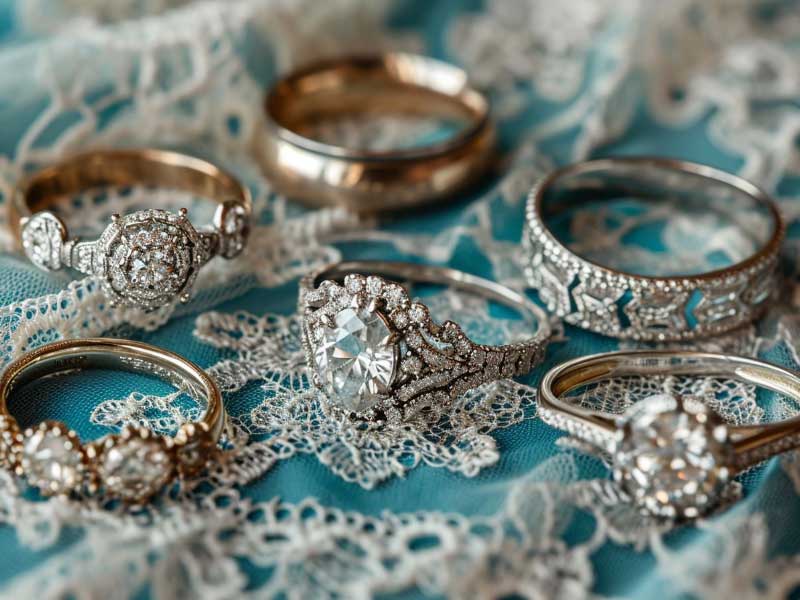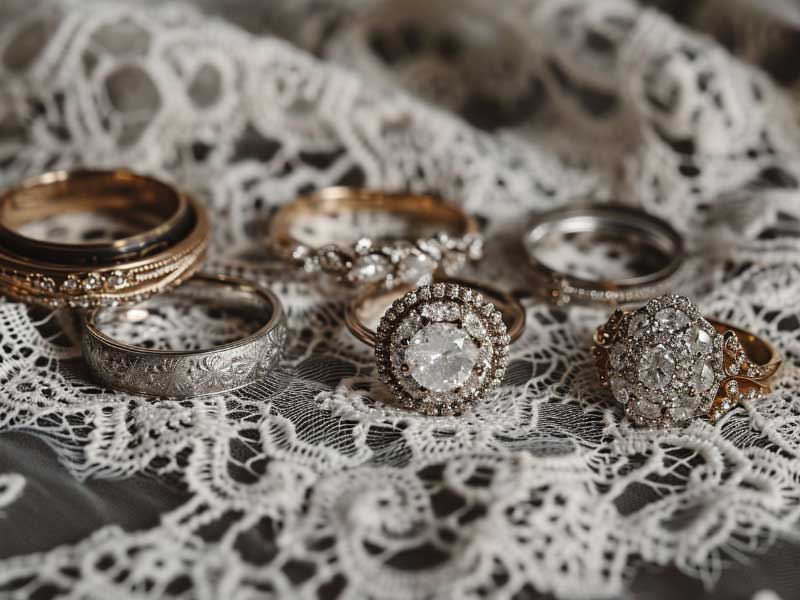
The Ultimate Guide to Engagement Bands and Wedding Rings
Choosing the perfect ring to symbolize your love and commitment can be both exciting and a bit overwhelming.
Whether you’re starting your journey down the aisle or simply dreaming of the day, it’s important to understand the difference between engagement bands and wedding rings.
These two pieces of jewelry may represent similar ideals, but they come with their own unique stories and traditions.
Did you know that in many Western cultures, engagement rings are worn on the fourth finger of the left hand because it was once thought this finger contained a vein that led directly to the heart?
This romantic notion adds depth to why we cherish these symbols so much.
Our guide will walk you through distinguishing features like design, tradition, and symbolism while offering practical advice for selecting rings that reflect your personal style and relationship.
Ready for some timeless tips?
Key Takeaways
- Engagement rings typically feature a main stone and symbolize the promise to marry, while wedding rings are exchanged during the ceremony and are usually simpler.
- Both engagement bands and wedding rings carry deep symbolic meanings with engagement representing a commitment and wedding rings signifying unity and eternity.
- Cultural expectations influence how these rings are chosen and worn; some traditions dictate specific designs or ways of wearing them but modern preferences allow for more personalized expressions.
- Quality is key when choosing these symbols of commitment, so selecting durable materials like gold or platinum is important as well as considering style that reflects personal taste.
- To ensure a cohesive look between engagement bands and wedding rings, consider pairing matching metals, coordinating styles, incorporating custom details or engravings.
The Distinction between Engagement and Wedding Rings
Engagement rings traditionally symbolize a promise of marriage, often featuring a dominant stone or gemstone, while wedding rings are exchanged during the ceremony and typically have a simpler design.
Understanding these differences can help in selecting the right ring for each stage of the relationship.
Historical context and traditions

For centuries, engagement rings have symbolized a promise of marriage, with their roots dating back to ancient Rome.
Traditionally, they feature a dominant stone, which often is a diamond set in precious metal.
The wedding band, on the other hand, represents the fulfillment of that promise and is exchanged during the wedding ceremony.
It’s usually simpler than the engagement ring and often made of matching metal.
Cultural rituals have evolved into highly individual expressions involving these pieces of jewelry.
In many cultures, both rings are worn on the ring finger with personal preference guiding whether they’re worn separately or together.
Throughout history, gemstones added to either band have signified different meanings—from love to strength—contributing to their rich tradition as bridal accessories essential to marital symbolism.
New designs emerge over time but respect for tradition maintains a strong presence in their selection and use.
Design and aesthetic differences
Moving from history to aesthetics, engagement bands and wedding rings often showcase distinct designs and trends.
Engagement rings are typically more elaborate, featuring a prominent diamond or gemstone set high on the band to catch light and draw attention.
The size of the stone can vary greatly, with carat weight being a significant factor in both appearance and value.
These bands are designed to stand out, symbolizing the promise of marriage.
In contrast, wedding rings tend to embrace simplicity and tradition.
Often made from precious metals like gold or platinum, these bands are usually less ornate than engagement rings.
They might include engraved details or embedded stones but generally maintain a sleeker profile that complements rather than competes with their flashier counterparts.
This difference underlines the separate roles each ring plays in marital symbolism – one marks a commitment to wed while the other solidifies the act of marriage itself.
The Need for Both Rings

The need for both engagement and wedding rings goes beyond mere tradition or cultural expectations.
These rings hold significant symbolic importance, marking the beginning of a lifelong commitment and serving as a tangible representation of love, unity, and devotion between partners.
Symbolic importance
Engagement bands and wedding rings carry deep symbolic meanings that often reflect a couple’s love, commitment, and the journey they are about to embark on together.
An engagement band signifies a promise, a prelude to the lifelong bond symbolized by the exchange of wedding rings.
It tells a story of aspiration for the future, hinting at plans made and dreams shared between two people who have chosen each other.
Wedding rings take this significance even further by representing unity and eternity – circular shapes with no beginning or end that speak to everlasting love.
These pieces of jewelry become daily reminders of vows taken and the continuity of partnership through life’s ups and downs.
They serve as tangible witnesses to one’s attachment and devotion, becoming treasured heirlooms passed down through generations as symbols not only of marital status but also family heritage.
Cultural expectations
Cultural expectations play a significant role in the choice and wearing of engagement and wedding rings.
In many cultures, there are specific customs and traditions surrounding the exchange of these rings.
For instance, some cultures place a strong emphasis on the design, metal, or gemstone of the rings as symbols of love and commitment.
Furthermore, certain societies have unique rituals related to presenting and exchanging these rings during engagement ceremonies and weddings.
Another cultural expectation is how these rings are worn. Different cultures have varying customs when it comes to which finger to wear each ring on.
Additionally, there may be specific guidelines for who should purchase or bestow the rings upon whom within a particular culture or social context.
How to Wear Engagement and Wedding Rings

When it comes to wearing engagement and wedding rings, there are traditional ways of wearing them that have been followed for generations.
However, modern preferences also play a significant role in determining how couples choose to wear their rings.
It’s important to consider personal comfort and daily activities when deciding on the best way to wear these meaningful pieces of jewelry.
Traditional ways of wearing
Engagement and wedding rings are traditionally worn on the fourth finger of the left hand, as it was believed to have a direct connection to the heart.
The engagement ring is typically worn first, closest to the knuckle, followed by the wedding band.
Some opt to move their engagement ring to their right hand during the ceremony and then switch it back after exchanging vows.
Modern and personal preferences
When it comes to wearing engagement and wedding rings, modern couples have the freedom to express their personal preferences.
Some prefer to wear both rings on the same finger, while others choose to stack them or wear them separately.
Additionally, individuals may opt for custom designs that reflect their unique style and personality, deviating from traditional ring styles.
With the ability to tailor their choices based on individual tastes and lifestyle, couples can ensure that their rings are not only symbolic but also a true reflection of their relationship.
Navigating through the myriad of options available today allows couples to find rings that resonate with their values and aesthetic preferences.
The evolution toward personalized choices empowers couples in selecting symbols of commitment that hold significant meaning for them.
Selecting the Perfect Rings
When selecting the perfect engagement and wedding rings, it’s important to consider the quality and style that best reflects your personal preferences.
Pairing and matching tips can also help ensure a cohesive and complementary look for both rings.

Considerations for quality and style
When selecting engagement and wedding rings, it’s crucial to consider both quality and style.
Quality is paramount as these rings are not just accessories but enduring symbols of commitment.
Look for durable materials like platinum, gold, or palladium for longevity.
For gemstone-adorned rings, prioritize stones with high clarity and color grade for a stunning yet timeless appearance.
Equally important is finding a style that reflects your personality and complements your partner’s ring.
Whether classic or modern, ensure the design resonates with you both while maintaining a cohesive look when worn together.
As you evaluate different options, keep in mind the significance of craftsmanship as it directly impacts the overall quality and aesthetic appeal of the ring.
Attention to detail in intricate designs can elevate the piece from being merely beautiful to something truly exquisite.
Pairing and matching tips
When selecting an engagement ring and wedding band, consider matching metals for a cohesive look.
For instance, if the engagement ring is made of platinum, opt for a platinum wedding band to ensure they complement each other seamlessly.
Another essential tip is to take into account the width of each ring. For a balanced appearance, choose a wedding band that complements the width and style of the engagement ring.
Ultimately, finding rings that harmonize in metal type and design will create an elegant and unified pairing.
To achieve a coordinated look, it’s crucial to consider the setting of the engagement ring when choosing a wedding band.
If the engagement ring features intricate details or protruding stones, seek a wedding band that fits flush against it to avoid any potential overlap or misalignment between the two rings.
Conclusion
In summary, understanding the differences between engagement bands and wedding rings is essential for any couple planning their commitment. Additionally, keep in mind that you may want to consider a wedding ring upgrade down the road.
The practical advice provided in this article offers a clear path to selecting the perfect rings that match individual styles and preferences.
Have you considered how these strategies can enhance your decision-making process?
By implementing these insights, couples can ensure that their chosen rings align with their cultural expectations while symbolizing their commitment effectively.
It’s important to recognize the impact of these choices as they reflect personal values and traditions.
Further exploration into this topic will empower individuals to make informed decisions about selecting rings that resonate with them personally.
FAQs
1. What’s the main difference between an engagement band and a wedding ring?
Engagement bands typically feature one prominent gemstone, representing a promise of marriage, while wedding rings are exchanged during the ceremony to symbolize the commitment to each other.
2. Can you wear both an engagement band and a wedding ring together?
Yes, it is common for people to wear their engagement band along with their wedding ring on the same finger as a pair that represents both the commitment and marriage.
3. Are there specific styles or metals used for engagement bands and wedding rings?
Engagement bands often have diamonds or other precious stones set in platinum or gold, whereas wedding rings might be simpler in design but also come in various metals like gold, silver, or tungsten.
4. Is it okay to choose my own style for my engagement band and wedding ring?
Absolutely! It’s important to select a style that suits your personal taste; after all, these rings will be symbols of your love and you’ll likely wear them every day.




